#vodou deities
Text
Damballa Wedo & Ayida Wedo.
I made an original digital art piece of Vodou deities Damballa Wedo. The white snake & Ayida Wedo. the rainbow. The Serpent And The Rainbow.

#ayida wedo#damballa wedo#Vodou deities#like and/or reblog!#spiritual#google search#rootwork#new orleans voodoo#haitian vodou#Voodoo art#computer art#digital art#ai artwork#Black voodoo#Deities
23 notes
·
View notes
Text
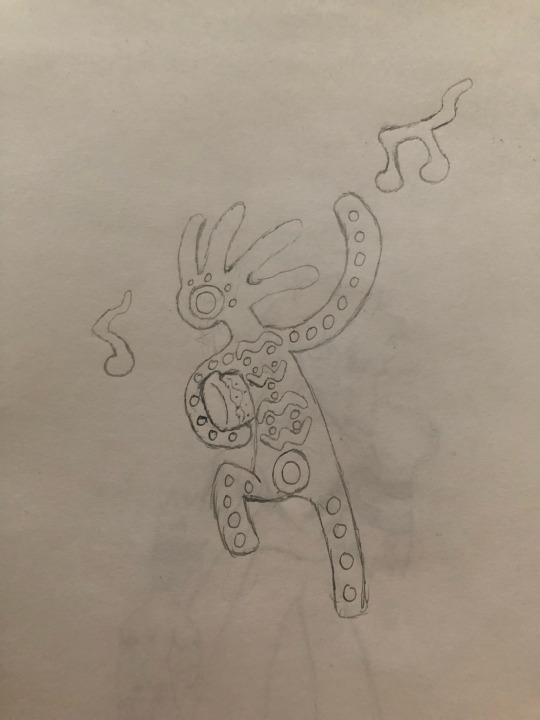
Joyboy, the Vodou spirit of hope and music, whoever hears the beat of his drum cannot resist the temptation to dance and laugh their worries away.
8 notes
·
View notes
Text

DC characters - Erzulie
#dc comics#dc vertigo#erzulie#dc characters#house of whispers#loa#haitian vodou#dc#dc black label#fanart#fan art#goddess#dc deities#the sandman universe
56 notes
·
View notes
Text

fun facts
"Californication" is about the dark underbelly of Hollywood and how it destroys just as fast as it creates. the lyrics mention Kurt Cobain, silver-screen actors, plastic surgery, the murder of actress and playmate Dorothy Stratten, and teen pregnancy
"Santeria" tells the story of a man considering Santeria to get revenge on his unfaithful girlfriend and her lover. Santeria is a Caribbean religion similar to Haitian vodou. despite racist depiction in media, both practices focus on praying to and communicating with spirits/deities for help, protection, and guidance
400 notes
·
View notes
Text
AFRICAN VOODOO
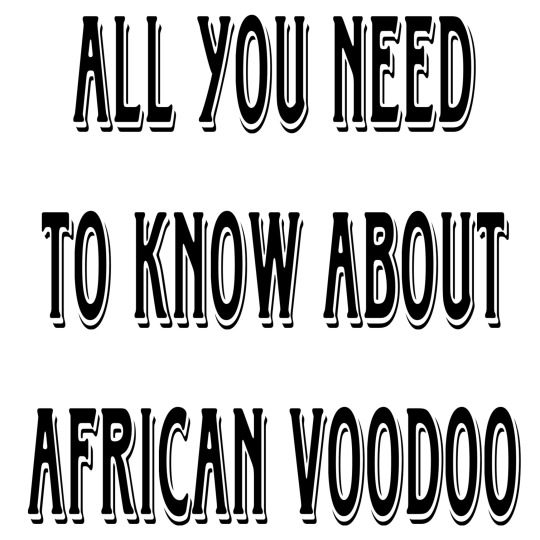
The deep truth about AFRICAN VOODOO
African Voodoo: Unraveling the Mysteries of a Rich Spiritual Tradition
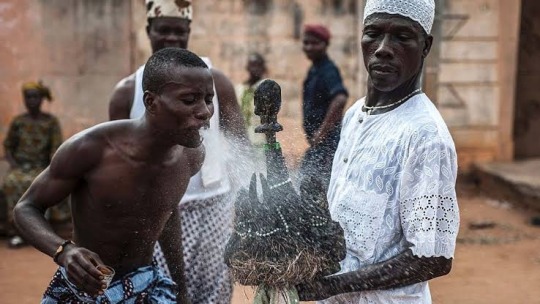
African Voodoo, often shrouded in mystery and misconceptions, is a complex and fascinating spiritual tradition with deep-rooted cultural significance. This ancient belief system, practiced in various forms across the African continent and the African diaspora, offers a unique perspective on the relationship between humans, nature, and the divine. In this article, we will delve into the world of African Voodoo, exploring its history, beliefs, rituals, and its enduring impact on the cultures and societies where it thrives.
A Diverse Tradition
Voodoo, also spelled Vodou or Vodun, is not a monolithic belief system; rather, it is a diverse and adaptable spiritual tradition that has evolved differently in various regions of Africa and beyond. Its origins can be traced back to the indigenous religions of West and Central Africa, where it was practiced by different ethnic groups. Over time, African Voodoo underwent syncretism with Catholicism and indigenous beliefs in the Caribbean, particularly in Haiti, giving birth to Haitian Vodou, which is perhaps the most well-known form of Voodoo.
Core Beliefs
At its core, African Voodoo centers around the veneration of spirits, ancestors, and deities. These spirits are believed to have the power to influence human life and the natural world. Each spirit has a specific domain, and practitioners seek their guidance and assistance through various rituals and offerings. Ancestor worship is a fundamental aspect of Voodoo, as it connects the living to their familial lineage and heritage.
The Loa, or spirits, are a central focus of Voodoo ceremonies. These spirits are intermediaries between humans and the ultimate divine force. Practitioners often enter trance-like states to communicate with the Loa, who possess them temporarily during rituals. The Loa are known for their distinct personalities and preferences, and offerings such as food, drinks, and dance are made to appease and honor them.
Rituals and Practices
Voodoo rituals are colorful and lively events filled with drumming, dancing, singing, and the use of symbolic objects. Rituals are often held in temples or outdoor spaces, and they vary widely depending on the specific tradition and purpose. Some rituals are celebratory, while others are intended to seek protection, healing, or guidance.
One of the most famous Voodoo rituals is the "Voodoo Doll," which is often misunderstood. These dolls are not meant for causing harm but are used as tools for healing or connecting with a specific person's spirit. Pins may be used symbolically to focus intention.
Voodoo in the African Diaspora
The transatlantic slave trade played a significant role in spreading African Voodoo to the Americas, particularly in regions like Haiti, New Orleans, and Brazil. In these places, Voodoo underwent further syncretism with local beliefs and Catholicism, resulting in unique variations of the tradition.
Haitian Vodou, for instance, is a vibrant blend of African Voodoo, Catholicism, and indigenous Taino beliefs. It has had a profound impact on Haitian culture and played a central role in the struggle for independence from colonial rule.
Misconceptions and Stereotypes
African Voodoo has been the subject of many misconceptions and stereotypes, often portrayed negatively in popular culture. These portrayals frequently focus on the more sensational aspects of Voodoo, such as curses and zombies, rather than its rich cultural and spiritual dimensions. It's important to recognize that Voodoo is a legitimate religious practice for millions of people, and like any belief system, it encompasses a wide range of beliefs and practices.
African Voodoo is a complex, multifaceted spiritual tradition with a deep and enduring cultural significance. It is a testament to the resilience of African heritage and the ability of beliefs to adapt and evolve over time. Beyond the stereotypes and misconceptions, Voodoo represents a profound connection between humans, nature, and the divine—a connection that continues to shape the lives and cultures of those who practice it.
Communication with the spirits, often referred to as Loa or Lwa in Voodoo, is a central aspect of Voodoo rituals and practices. Here's an overview of how practitioners communicate with these entities:

1. **Rituals and Offerings**: Voodoo rituals are the primary means of communication with the spirits. Practitioners gather in a designated sacred space, such as a temple or outdoor altar. They often create an elaborate ritual environment with symbols, candles, and ceremonial objects. Offerings, including food, drinks, tobacco, and other items, are presented to specific spirits to gain their favor and attention.
2. **Dance and Music**: Music and dance are essential elements of Voodoo ceremonies. Drumming and chanting create a rhythmic and trance-inducing atmosphere. Through dance and music, practitioners enter altered states of consciousness, allowing them to connect with the spirits more profoundly. It is believed that the spirits may possess individuals during these ceremonies, providing a direct channel for communication.
3. **Possession and Trance**: One of the most distinctive aspects of Voodoo rituals is the concept of spirit possession. Practitioners, often referred to as "servants of the spirits," may enter a trance-like state during which a particular Loa or spirit is believed to take control of their body. In this state, the possessed individual may speak in the voice of the spirit, offering guidance, advice, or requests on behalf of the spirit.
4. **Divination**: Divination is another way to communicate with the spirits in Voodoo. Practitioners may use various divination tools such as tarot cards, cowrie shells, or casting of objects to seek guidance from the spirits. These divination practices help practitioners understand the desires and intentions of the spirits and may provide insights into their own lives.
5. **Prayer and Invocation**: Voodoo practitioners often use prayer and invocation to establish a connection with the spirits. Specific prayers or invocations are recited to call upon a particular spirit's presence and assistance. These prayers are typically passed down through generations and may be spoken in a specific language or dialect.
6. **Voodoo Dolls**: Contrary to popular misconceptions, Voodoo dolls are not used for causing harm but are symbolic tools for communication. They can represent a specific person or spirit and are employed in rituals to convey intentions, requests, or healing energy to the spirits associated with them.
It's important to note that communication with the spirits in Voodoo is a deeply spiritual and cultural practice, and the methods may vary among different Voodoo traditions and communities. Voodoo practitioners believe that these rituals and practices maintain a reciprocal relationship with the spirits, offering offerings and devotion in exchange for protection, guidance, and assistance in various aspects of life.
Masquerades and Voodoo in Africa: A Cultural Tapestry of Spiritual Expression
Africa is a continent rich in cultural diversity, and its spiritual practices are as varied as its landscapes. Among the many vibrant traditions that permeate African culture, masquerades and Voodoo (often spelled Vodun or Vodou) hold significant places in the hearts and lives of its people. This article explores the fascinating intersection of masquerades and Voodoo, shedding light on how these practices are intertwined with African spirituality.
**Masquerades: The Embodiment of Spirits**

Masquerades are a prominent cultural phenomenon across Africa, characterized by elaborate costumes, masks, and dances. These performances serve multifaceted purposes, including entertainment, social commentary, and spiritual expression. However, it's the latter aspect, the spiritual dimension, that ties masquerades to Voodoo and other indigenous African belief systems.
1. **Role of Ancestors**: In many African cultures, masquerades are a means of connecting with ancestors and spirits of the deceased. The masks and costumes worn by performers often represent these spirits. During masquerade ceremonies, participants believe that the spirits inhabit the masks and interact with the living. This interaction serves as a way to honor and seek guidance from the ancestors.
2. **Protection and Cleansing**: Some masquerades have protective roles in communities. They are believed to ward off evil spirits, illnesses, or other malevolent forces. These masquerades often perform purification rituals, symbolically cleansing the community and its members.
3. **Harvest and Fertility Celebrations**: Masquerades are frequently associated with agricultural and fertility rites. They may perform dances and rituals to ensure a bountiful harvest or to promote fertility among the community members.
4. **Social Order and Governance**: Masquerades also play a role in enforcing social norms and maintaining order within communities. They may act as judges, mediators, or enforcers of communal rules during their performances.
**Voodoo: The Spiritual Heartbeat**
Voodoo, a widely practiced religion across West Africa and its diaspora, is deeply entwined with masquerades and the spiritual fabric of the continent.
1. **Ancestor Worship**: Voodoo places a significant emphasis on ancestor worship, much like masquerades. Practitioners believe that the spirits of ancestors are ever-present and can influence the living. Offerings, rituals, and masquerade performances are ways to honor and seek the guidance of these spirits.
2. **Connection to Nature**: Voodoo, like many African belief systems, recognizes the close relationship between humans and nature. It views natural elements, such as rivers, forests, and animals, as inhabited by spirits. Masquerades often incorporate nature-centric symbolism in their performances.
3. **Trance and Possession**: Both Voodoo and certain masquerades involve altered states of consciousness. In Voodoo, devotees may enter trances and become possessed by spirits, similar to the possession experiences during some masquerade ceremonies. These states facilitate direct communication with the divine.
4. **Rituals and Sacrifices**: Offerings and sacrifices are common in both Voodoo and masquerade traditions. These rituals are believed to appease spirits and seek their favor.
**Cultural Resilience and Transformation**
While masquerades and Voodoo have endured the test of time and colonization, they have also adapted and evolved. In the African diaspora, especially in the Americas, they fused with other cultural elements and religions, giving rise to unique traditions such as Haitian Vodou and New Orleans Voodoo.
masquerades and Voodoo in Africa are vibrant expressions of spirituality, culture, and identity. They are living traditions that continue to shape the lives and beliefs of countless individuals and communities, offering insights into the enduring resilience and adaptability of African cultures in the face of change and adversity.
The timing for Voodoo practices, like many spiritual traditions, can vary depending on the specific tradition, the purpose of the practice, and the preferences of the practitioner. There is no universally "best" time for Voodoo practice, but certain times and occasions are commonly observed:
1. **Festival Days**: Many Voodoo traditions have specific festival days or holidays when practitioners gather to perform rituals and ceremonies. For example, in Haitian Vodou, the Festival of the Ancestors (Fèt Gede) is a significant event where people honor and communicate with their ancestors. These festivals often have fixed dates in the Voodoo calendar.
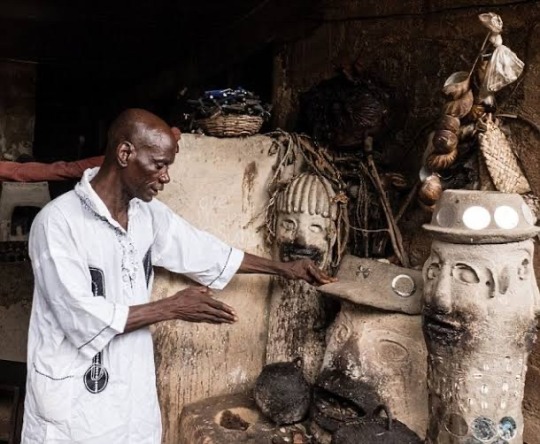
2. **Full Moon and New Moon**: Lunar phases are significant in various spiritual practices, including Voodoo. Some practitioners prefer to conduct rituals during the full moon or new moon, believing that these phases are particularly potent for spiritual work. The full moon is often associated with amplifying energy and intentions, while the new moon is seen as a time for new beginnings.
3. **Nighttime**: Many Voodoo rituals take place during the nighttime. This is believed to be a time when the veil between the spiritual and physical realms is thinner, making it easier to communicate with the spirits. Candlelit ceremonies, drumming, and dancing are common elements of Voodoo rituals conducted at night.
4. **Personal Preference**: Individual practitioners may have their own preferred times for Voodoo practice based on their personal experiences and beliefs. Some may feel a stronger connection to the spirits during specific times of the day or year.
5. **Life Events**: Voodoo is often integrated into various life events such as births, marriages, and funerals. The timing of these rituals is determined by the occurrence of these events.
6. **Consulting a Voodoo Priest/Priestess**: For more specific guidance on the timing of Voodoo practices, consulting a Voodoo priest or priestess is advisable. They can provide insights based on their knowledge and experience within their particular Voodoo tradition.
It's essential to remember that Voodoo is not a monolithic practice; it encompasses various traditions and regional variations, each with its own customs and beliefs. Therefore, the best time for Voodoo practice can differ significantly from one tradition to another. Additionally, Voodoo is deeply rooted in cultural and spiritual contexts, so practitioners often follow the customs passed down through generations within their specific communities.
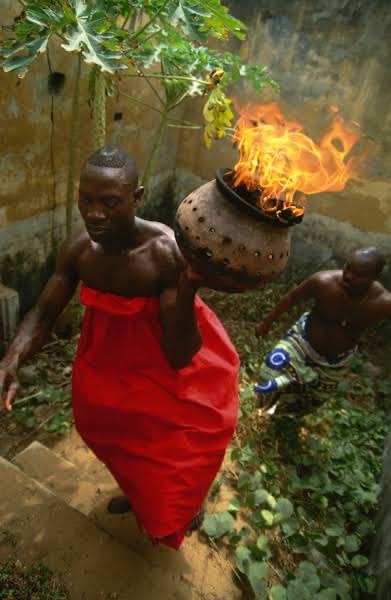
#life#animals#culture#aesthetic#black history#history#blm blacklivesmatter#anime and manga#architecture#black community#heritagesites#culturaltours
259 notes
·
View notes
Text
Personal Do Not Read Witchy Author List
There will be a google doc with updates as I find more authors to avoid. These are all my own personal opinion and I do take the author's actions into account when judging their ability to write legitimate information.
TW: Slavery, serial killers, racism, TERFs, creeps, neonazis, asylums, and a slew of other super unsavory things. I tried to make this list as PG as possible while highlighting the issues with these individual people.
*Alestier Crowley. *
He's a literal piece of garbage. Misogynistic, thief of a toooon of closed practices, has entire cults still dedicated to him, called himself a voice of God (both Abrahamic and apparently like 5 Egyptian deities??? I mean excuse me sir how about no??)
He also declared himself ‘above’ Gods back in 1922 calling himself Ipssissimus. I hate Crowley so much I have literally stuck a picture of him to a dartboard before. He can suck an egg in the afterlife. He also put his own wife in an asylum for 'alcoholism’ because she wanted a divorce.
The only thing he ever did right was get kicked down a flight of stairs at a temple once by a poet.
*Anastasia Greywolf*
Appropriates at least Jewish practices if not every Indigenous practice there is. Wholeheartedly encourages people to use magic instead of going to a doctor for things like oh I dunno EPILEPSY And claims she has spells for like Marvel-level super powers which uh no Ana. You don't. Lots of Christianity for a supposedly FULL pagan and wiccan author. Her spells are all controlled like...so wrong. So, so wrong. Don't ask please. I can't begin to describe it. Advocates for smudging and uses phrases like "Cherokee Rituals", and the Romani G-slur.
*Gerald Gardner*
Made his own branch of wicca, the first technically, and his own coven had to make rules just so he wouldn't spill everything to any reporter that asked. Used Crowley as a main resource.
*Jason Miller*
Claims to do Hoodoo. A horrible formatter, and generally super dismissive of being a rootworker and other potentially closed practices, has not been initiated. Has claimed that anyone can petition/pray to Papa Legba without initiation because "Vodou is a congregational religion/practice". From the Vodou and Haitian Vodou practitioners I have talked to that is VERY incorrect, it may be congregational but you still have to be involved in the community to be trusted with those practices because so much of it has been bastardized for media and racism purposes. He is also a student of Catherine Yronwode, who is another SUPER problematic figure in the Hoodoo/Rootwork community.
A link of his own words on culture appropriation which includes mild inaccuracy towards Indiginous Peoples and that they don’t ‘own’ certain practices when it’s very clear the wording of those practices DOES in fact come from those peoples. He’s fine with people being Yogis, or Shamans, or calling satchel spells mojo bags, and other such phrases and won’t correct people if they use such words out of context because “language changes”. Also says if someone within a practice says it’s closed to go to ANOTHER AND ANOTHER until you find someone willing to teach you??? That’s not how it works sir.
Source: https://www.strategicsorcery.net/on-cultural-misappropriation/
*Lisa Chamberlain*
Not an actual person. This is a ghost writer name for a bunch of garbage literally copy and pasted from wikipedia into books. I wish I was kidding.
*Lisa Leister/Lester/whatever other spelling she's used.*
Such a major TERF. Like JK Rowling level TERF. Claims magic comes from a womb so anybody that doesn't have one isn't a real witch. Like WTF lady.
*Raymond Buckland*
Where to start...uses the G-slur often. (His grandfather was romani so it blurs the line of blood quantum.) Very sexist and obsessed with the idea of a woman getting uh...undressed for rituals while men stay dressed and more things I cannot say ina PG space??? As magic?? VERY anti-minor and LGBTQA+. Toxic, just plain toxic. Can't do it. I have read his Blue Book and it's the least problematic thing he wrote. I'm alright with it.
*Silver Ravenwolf*
WhOOO boy. So super anti-christian, which is fine and dandy...if you didn't claim to be in a lineage of braucherei/hexerei. Wiccan, like the type of wiccan that says no other witchcraft exists and yet has written folk magic books??? She really needs to make up her mind. Claims Satanists don't actually exist. Claims most Jewish powers worshiped "the Goddess" (whoever that is)??? Very cult-like language about "not telling friends and family about your new life/reality/experience/whatever". Also SO MUCH APPROPRIATION. SO SO MUCH. She also gets her history wrong, on a lot of basic information that most non-witches know about like say the Salem Witch Trials.
*Catherine Yronwode*
Ooh man. So Catherine Yronwode’s career started as a comic book artist. She’s worked on such things like the Elvira comic, DNAgents, and a gaggle of super controversial trading cards which included the Kennedy Assasination, a serial killer collection, and the AIDS epidemic.
Of which she was sued for using one half of the Hillside Stranglers duo in said killer trading cards without his permission, the judge sadly threw the case out because and this is a quote, “ If Bianchi had been using his face as a trademark when he was killing women, he would not have tried to hide it from the police.”
There were two more from her comic days, but those aren’t super relevant besides the one that pushed the envelope of what sort of trading cards should be sold to children.
On the magical side of things, I will be blunt here: As one of the ‘big bads’ of the Rootwork/Folk/Hoodoo community? I really REALLY dislike her. She has made numerous false claims about New Orleans/Haitian Vodou and that it’s only a very recent practice, non-religious, and slaves never used it because it didn’t exist yet??? History books and entire generations will disagree. An example would be this link of an open letter to her written by a New Orleans Voodoo practitioner and someone she wrote a whole article about: https://conjureart.blogspot.com/2013/10/open-letter-to-cat-yronwode-and-lucky.html
She owns a few different websites namely https://www.luckymojo.com/, has written numerous Hoodoo based books, and actively has accused numerous people who have asked her for sources and or disagreed with her of plagiarism and has slung more mud that you can shake a stick at.
She also praises a book on Marie Laveau and yet discredits herself by calling New Orleans Voodoo a new religion/neopractice??? She’s just confusing as all heck to me.
*Christian Day*
This guy’s just a creep. One stuck in the early 2000s mall goth phase even though he’s over 50. He also appropriates Hoodoo and owns two Hoodoo shops as well as multiple other witch shops in Salem and recently New Orleans on the French Quarter (Which is pure tourist fodder and not a reflection of true New Orleans Voodoo/Vodun/Rootwork). He has also harassed ex-employees so badly it’s landed him in court. His book The Witch’s Book of the Dead also reads very much like a list of accomplishments rather than anything useful. All about his television spots and experiences doing that. (Did I mention he was in an episode of Ghost Adventures? Yes, that one with Zac Bagans??? And it did not make us witches look too great, honestly speaking.)
Sources for Harassment Claims: https://www.cbsnews.com/news/salem-witch-gets-protective-order-against-warlock/
https://www.wcvb.com/article/warlock-christian-day-ordered-to-stay-away-from-salem-witch/8228072
*Yvonne and Gavin Frost*
I dunno how else to say this, I really don’t. These two? Pedophiles. Multiple writings of theirs included not-safe-for-work-or-children rituals that must include minors. Avoid. AVOID AVOID. AVOID ANYONE WHO USES THEM AS A RESOURCE! This should NOT be okay in any circle. They are VERY used within the Wicca religion so please be careful!!
*Orion Foxwood*
Some of his information is very sound! I can’t fault him there. He does have a tendency to blend different traditions without actively TELLING you he’s blending them though. He’s and this is a direct quote,
“He is a witch and Elder in Romano Celtic-Traditional Craft, High Priest in Alexandrian Wicca and teacher of the Faery Seership tradition. He is also the founding Elder of Foxwood Temple and a primary founder of the Alliance of the Old Religion, a national network of covens in his line that have united to preserve the ways of his Elders. He was the co-director of Moonridge, a center for metaphysical, Craft and Faery studies in Maryland”
That’s an awful lot of traditions to juggle and not only write on but actively teach. He also performs conjure, which in of itself might not be an issue but Conjure usually blends into Hoodoo really quickly if one isn’t careful! A lot of the traditions he talks about from his family sound quite familiar, he’s clearly from Appalachia but his books on the subject blend in his other practices instead of keeping them separate.
*Starr Casas*
She’s in the same category as Orion, only she doesn’t necessarily give her credentials to be teaching Hoodoo, and even wrote a whole book filled with Hoodoo love spells. She also co-owns a French Quarter Conjure Shop, which if you ask any practitioners from New Orleans...is catered to pure tourists and not a true example of the crafts from the area.
*Shawn Engel*
I’m gonna be blunt here. More appropriation of the Jewish practices, Hoodoo, and other information that is just plain UPG without saying it’s UPG and encourages throwing hexes at political party members solo. I read The Power of Hex and had to put it down numerous times just to gather myself and not throw it away, I don’t know if it was tone or sheer level of appropriation...likely both.
*Kate Freuler*
Of Blood and Bones is chock full of Hoodoo, full stop. Only acknowledges that something comes from Hoodoo once and also gets basic mythology information on the Deities she mentions wrong in some cases. Also a lot of the book seems to be UPG because the bibliography is super small for a 300 page book.
*Dorothy Morrison*
I picked up Utterly Wicked once. A very odd book full of Hoodoo and Vodun spellwork and misinformation, the author is also Garderian Wiccan so even the writing of a book full of hexes is slightly...concerning compared to the Wiccan traditions and redes. Odd is the best I have to describe how I personally feel. I will say this again: Voodoo Dolls are not used to cause pain, stop bastardizing that single aspect of the practice. Thank you.
*Helena Blavatsky*
I dunno how else to say this either, her philosophy and occult knowledge, called Theosophy is a portion of what inspired Hitler. Pure unadulterated racism veiled in a ‘Atlantian Race Theory”. Horrible stuff, read for a class project once and felt disgusting.
*Christopher Penczak*Whoo boy. On the surface he seems alright, one of the first ‘male’ witches I had ever heard of except for Scott Cunningham. But the more you dig into his work the more inaccuracies and Christian bashing you see. For example: Christianty was the first patriarchal society. Uhm...I believe you’re kinda forgetting the men who ran Rome and Greece there sir.
He also fully proposes the ‘burning times’ were like a ‘witch holocaust’. NO! NO IT WAS NOT. You can’t compare the hundreds of years and MAYBE a thousand-ish people dying to the millions that died in the short timespan the Holocaust was a thing. Fuck Christopher for that comparison and also for claiming it was a ‘burning time’ to begin with. (History says that most were hung...or tortured. Burning is a very small number of that list in general.
He makes a lot of sweeping statements and sees witchcraft as a religion and NOT a practice. He whitewashes, fully harps on the Wicca = witchcraft = religion thing and THEN hones in on the difference between “white and black” magic and how cursing is evil and yet highlights certain practices that actively practice...cursing...as they have for generations??? He (atleast) doesn’t demonize Satanism but does still backhand the idea anyway, that they CAN’T be witches because witches only ‘heal’.
Cultural appropriation and fetishization of ‘Native’ practices while calling them primitive all in the same breath, I just can’t with this guy. I really can’t.
*Amy Blackthorn*
Owns a tea brand called ‘Blackthorn Hoodoo Blends’ she is white. When questioned by BIPOC individuals she complains and blocks them instead of explaining why she chose the name Hoodoo for just teas. TEA. She is also the author of Blackthorn’s Botanical Magic, Sacred Smoke (A book on smudging yikes on trikes), and Blackthorn’s Protection Magic.
Proof of blocking: https://thisblackwitch.com/2016/04/01/blackthorn-teas-whose-culture-is-it-anyways/
*Tarl Warwick *
Is more commonly known as Styxhexenhammer666 on youtube and other social media sites. Has written a pile and I mean a PILE of occult based books including ones on Hermetic magic, ritualistic magic, demons, solomon, folk plants and healing, Kabbalah, and many MANY more.
He makes no claim to being Jewish, and given his political wishy washiness, and multitude of controversies which includes claiming the Holocaust wasn’t ‘that many dead’, Charles Manson deserved release because he was ‘extremely innocent and didn’t kill anyone’, and fairly recently also wrote and published a book on Critical Race Theory and why it’s ‘garbage’. I can’t support him no matter how accurate some of his information may be (if any at all).
*Temperance Alden*
This really pains me to say, Temperance in her Wheel of the Year book made a claim that birth control “stunted her magical abilities” because it affected her hormones…in OTHER words unless you are a perfectly hormone producing WOMAN you don’t have great magical power.
AVOID. AVOID. AVOID. That is a slippery slope to claiming medication will harm you, not to mention how TERF-y it is AND completely disregards that magic is for well…everyone. Such a stupid gatekeep-y concept.
*Sarah Kate Istra/Dver*
Advocates for using ‘spirit animals’ regardless of Indigenous beliefs and concerns. Is also a known ally with the Piety Posse, a neo-nazi group of pagans who claim the term polytheist can only apply to them and if you aren’t a Hellenistic pagan…you aren’t pagan at all. They also advocate for animal sacrifices, blood tests to prove purity, and other horrible HORRIBLE stuff.
*Sannion/H. Jeremiah Lewis*
Obvious Neo-nazi, keeps images of swastikas on his personal blog, and not the ones that the nazis stole from, the nazi one. And super SUPER transphobic.
*Edward P. Butler*
Major persecution complex, spends half his twitter complaining about how monotheists are destroying…I dunno…everything? Also defends Krasskova quite heavily. Antisemetic as well.
*Galina Krasskova*
Hellenic pagans watch out. Defends the AFA. A ringleader of the Piety Posse. There’s a lot more horrific stuff about her and I won’t go into extreme details. But TW: Romanticizes SA with deities, human sacrifice, animal sacrifice. Compares debating to the holocaust, lots of victim blaming, gatekeeping, and screams folkish.
*Diana Cooper*
Racist. Hard stop. Also appropriates chakras. Has a weird belief that food controls skin color and that Africa will never be a good country because it’s the solar plexus of the universe…or something like that. I got 20 pages into the book and literally couldn’t go any farther. Did I mention this book was supposedly on dragons???
*Judika Iiles*
So much appropriation, advocates for making altars and working with closed deities. Lots of incorrect information including dangerous spellwork like obsession spells. And one in particular that has roots in a racist stereotypes. Avoid please!
#witchblr#witchcraft#Authors to avoid#Will update in the future#If anyone has any questions about any of these please feel free to ask
330 notes
·
View notes
Photo

A manbo (also written as mambo) is a priestess (as opposed to a oungan, a male priest) in the Haitian Vodou religion. Haitian Vodou's conceptions of priesthood stem from the religious traditions of enslaved people from Dahomey, in what is today Benin. For instance, the term manbo derives from the Fon word nanbo ("mother of magic"). Like their West African counterparts, Haitian manbos are female leaders in Vodou temples who perform healing work and guide others during complex rituals.
This form of female leadership is prevalent in urban centers such as Port-au-Prince (the capital of Haiti). Typically, there is no hierarchy among manbos and oungans. These priestesses and priests serve as the heads of autonomous religious groups and exert their authority over the devotees or spiritual servants in their hounfo (temples).
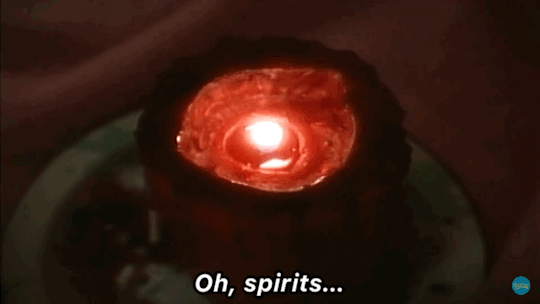
Manbos and oungans are called into power via spirit possession or the revelations in a dream. They become qualified after completing several initiation rituals and technical training exercises where they learn the Vodou spirits by their names, attributes, and symbols.
The first step in initiation is lave tèt (head washing), which is aimed at the spirits housed in an individual's head. The second step is known as kouche (to lie down), which is when the initiate enters a period of seclusion. Typically, the final step is the possession of the ason (sacred rattle), which enables the manbos or oungans to begin their work. One of the main goals of Vodou initiation ceremonies is to strengthen the manbo's konesans (knowledge), which determines priestly power.
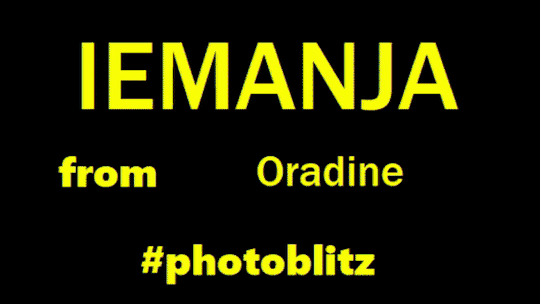
The specific skills and knowledge gained by manbos enable them to mediate between the physical and spiritual realms. They use this information to call upon the spirits through song, dance, prayer, offerings, and/or the drawing of vèvès (spiritual symbols). During these rituals, manbos may either be possessed by a loa (also spelled lwa, Vodou spirits) themselves, or may oversee the possession of other devotees. Spirit possession plays an important role in Vodou because it establishes a connection between human beings and the Vodou deities or spirits. Although loas can "mount" whomever they choose, those outside the Vodou priesthood do not have the skills to communicate directly with the spirits or gods. This is because the human body is merely flesh, which the spirits can borrow to reveal themselves via possession. manbos, however, can speak to and hear from the Vodou spirits. As a result, they can interpret the advice or warnings sent by a spirit to specific individuals or communities.

Cécile Fatiman is a Haitian manbo famously known for sacrificing a black pig in the August 1791 Vodou ceremony at Bois Caïman—an act that is said to have ignited the Haitian Revolution. There are also notable manbos within the United States. Marie Laveau (1801-1888), for example, gained fame in New Orleans, Louisiana, for her personal charm and Louisiana Voodoo practices.
Renowned as Louisiana's "voodoo queen", Laveau's legacy is kept alive in American popular culture (e.g., the television series America Horror Story: Coven).ne Mama Lola is another prominent manbo and Vodou spiritual leader in the United States. She rose to fame after the publication of Karen McCarthy Brown's ethnographic account Mama Lola: A Vodou Priestess in Brooklyn. Mama Lola's success provided her with a platform to challenge Western misconceptions of Haitian Vodou and make television appearances

#kemetic dreams#vodun#cecile fatiman#manbo#bois caiman#manbos#haitian#marie laveau#new orleans#new orleans voodoo#mama lola#vodou#lwa#oungan#nando#fan#west african#west african vodun#mother of magic#joey bada$$#brooklyn
257 notes
·
View notes
Text

Today's topic is relatively serious, witches! Let's unravel the enchanting tapestry of Wicca, witchcraft, and paganism, shall we? While these terms are often used interchangeably, they each have their own unique traditions, beliefs, and practices. Here's a glimpse into their similarities and differences:
Wicca: Wicca is a modern pagan religion that was developed in the mid-20th century by figures such as Gerald Gardner and Doreen Valiente. It is centered around the worship of nature and the reverence of the divine, often symbolized by a god and goddess representing the masculine and feminine energies of the universe. Wiccans celebrate seasonal festivals, known as Sabbats, and honor the cycles of the moon in their rituals. Wicca emphasizes personal responsibility, ethical behavior, and the practice of magic as a tool for spiritual growth and transformation.
Witchcraft: Witchcraft, on the other hand, is a practice rather than a religion. It encompasses a wide range of magical traditions, beliefs, and practices that are rooted in ancient folk magic, shamanism, and occultism. Witches may or may not adhere to a specific religious belief system, and their practices can vary greatly depending on individual preferences and cultural influences. Witchcraft is often associated with spellcasting, herbalism, divination, and connecting with the energies of the natural world.
Paganism: Paganism is a broad umbrella term that encompasses a diverse array of spiritual traditions and practices that are rooted in pre-Christian, indigenous, or nature-based religions. Paganism honors the sacredness of the earth and the divine energies that permeate all living things. It includes traditions such as Druidry, Heathenry, Hellenism, and various forms of polytheism, animism, and pantheism. Pagans celebrate seasonal festivals, honor ancestral spirits, and cultivate a deep connection with the natural world.
While Wicca, witchcraft, and paganism share some common themes, such as reverence for nature and the practice of magic, they are distinct paths with their own beliefs, practices, and communities. Some practitioners may identify with one or more of these paths, while others may follow their own unique spiritual journey. Whatever path you choose, embrace the magic within you and follow your intuition as you explore the mysteries of the universe. 🌙✨

In the realm of spiritual practices and religions, some traditions are considered "closed," meaning they are intended for specific cultural or ethnic groups and are not open to outsiders or those who do not belong to those groups. The reasons for a tradition being closed vary and can include cultural preservation, respect for ancestral traditions, and the protection of sacred knowledge. Here are some examples of closed practices or religions and why they are considered as such:
Native American Spirituality: Many Indigenous tribes and nations have spiritual practices that are considered closed to outsiders. These traditions are deeply rooted in specific cultural contexts and are passed down through generations within tribal communities. Outsiders are often discouraged from appropriating or practicing these traditions out of respect for Indigenous sovereignty and the protection of sacred ceremonies and knowledge.
Vodou (Voodoo): Vodou is a syncretic religion that originated in Haiti and West Africa, blending elements of African spiritual traditions with Catholicism. It is considered a closed religion because it is deeply intertwined with Haitian culture and history and is traditionally practiced within specific communities. Outsiders are generally not encouraged to practice Vodou without proper initiation and training, as it involves working with powerful spirits and deities.
Shinto: Shinto is the indigenous religion of Japan and is deeply rooted in Japanese culture and history. It involves the worship of kami (spirits or deities) and the practice of rituals at shrines and sacred sites. While Shinto is open to participation by anyone, certain aspects of Shinto practice, such as the inner workings of Shinto priesthood and some shrine rituals, are considered closed to outsiders.
Certain forms of Witchcraft: Some forms of witchcraft, particularly those rooted in specific cultural traditions or lineages, may be considered closed practices. For example, some forms of African diasporic witchcraft, such as Hoodoo and Santeria, are traditionally practiced within specific cultural communities and are not open to outsiders without proper training and initiation.
It's important to approach spiritual practices with respect, humility, and sensitivity to cultural and historical contexts. While it's natural to be curious about different traditions, it's essential to recognize and honor the boundaries of closed practices and to seek guidance and permission from practitioners within those traditions before engaging with them.

In closed practices, certain aspects are not open for use or appropriation by individuals who do not belong to the specific cultural or ethnic groups associated with those practices. These aspects often include:
Sacred Rituals and Ceremonies: Closed practices typically involve sacred rituals, ceremonies, and rites that are deeply rooted in specific cultural or ancestral traditions. These rituals may involve working with powerful spirits, deities, or ancestors and are considered sacred and highly respected within the community. Outsiders are generally not permitted to participate in or appropriate these rituals without proper initiation and training.
Traditional Knowledge and Wisdom: Closed practices often involve the transmission of traditional knowledge, wisdom, and teachings that are passed down through generations within cultural communities. This knowledge may include spiritual beliefs, practices, herbal remedies, and magical techniques that are specific to the cultural context and are not meant to be shared with outsiders without permission.
Sacred Objects and Symbols: Certain sacred objects, symbols, and artifacts are considered sacred within closed practices and are used in rituals and ceremonies as vessels for spiritual energy or as tools for communication with spiritual forces. These objects may include ritual implements, sacred plants, and religious symbols that hold deep significance within the cultural context. Outsiders are generally not permitted to use or appropriate these objects without proper understanding and respect for their meaning and purpose.
Initiation and Training: In many closed practices, initiation into the tradition and proper training are essential prerequisites for engaging in spiritual practices and rituals. Initiation ceremonies often involve a formal process of acceptance into the community and may include teachings, rituals, and oaths of allegiance. Proper training under the guidance of experienced practitioners is necessary to ensure the safe and respectful practice of closed traditions.
Cultural Appropriation: Outsiders are cautioned against appropriating elements of closed practices without proper understanding, respect, and authorization from the cultural community. Cultural appropriation involves the unauthorized use, adoption, or exploitation of cultural elements by individuals who do not belong to that culture, often resulting in the distortion, commodification, or trivialization of sacred traditions and practices.
It's important to approach closed practices with humility, respect, and a willingness to learn from and honor the cultural context from which they arise. Seek guidance from experienced practitioners within the community and always ask permission before engaging with sacred rituals, objects, or knowledge.
I really recommend doing your own research of what is and isn't sacred or closed practices for the sake of your own reputation as well as for the sake of yourself. There are many good collections of information available. This website provides alternatives as well. This website also highlights the new interests in witchcraft recently and notes the closed and sacred practices and why.
#magickkate#reference#witchblr#witches#kitchen witch#sigils#witch#witchcraft#queue the magick#green witch#witchy#beginner witch#college witch#baby witch tips#baby witch#cottage witch#quarantine witch#college witch tips#witch aesthetic#witchcraft 101#witchcraft community#witch community#witches of tumblr#witch tips#witchtok#witchy vibes#witchy shit#witchyvibes
29 notes
·
View notes
Text
PT 2 of "Alastor made a deal with Lwa" aka normal explanation
so the main thing about having a deal with Lwa is that they give a person the powers or whatever they want and in exchange the person gives them their soul and undertakes to supply them with food bc Lwa are hungry for blood


and that's what Alastor does!
he was given the powers and as we know he was a serial killer while alive (half confirmed, but a huge fanon fact) and continued this way in hell
also the deal with Lwa explains why the power shield Al made during the battle for the hotel couldn't be broken by angelic powers-

as we know, demons' power is vulnerable for angels' power and angels can't be hurt by it
according to Vodou religion, Lwa aren't demons - they're Deities
so that's why the exorcists were unable to pierce the shield with angelic weapons - because it was created by divine power essentially equal to theirs
another thing I noticed (not really a proof to anything, just an interesting detail) is that in Alastor's part of Finale he sings about how he wants to break the deal and "unclip" his wings to be free


and here we have his tentacles in his demon form situated right where wings are usually are
so here are my thoughts on Alastor's deal
:P
#hazbin hotel#hazbin hotel alastor#hazbin alastor#alastor#alastor hazbin hotel#lwa#vodou#hazbin hotel theory#alastor's deal#hazbin hotel alastor's deal
20 notes
·
View notes
Text
There’s a lot of gatekeeping and weirdly defined rules in the occult and spiritual spaces. I’m just gonna go ahead and say something that might ruffle some feathers, but hopefully it helps some confused or anxious folks out.
I see a lot of posts online and get a lot of questions about entities. Mainly “is it okay for me to work with this entity?” because of xyz reasons.
Firstly, let’s make something very clear. Cultural appropriation has a very specific definition. Cultural appropriation takes place when members of a majority group adopt cultural elements of a minority group in an exploitative, disrespectful, or stereotypical way.
I say this as a person of color that understands the negative impacts of cultural appropriation and racism. This may not be the popular opinion, but I don’t think that honouring or worshipping a God privately and quietly qualifies as this. There’s a big difference between appropriating a culture and their customs and worshipping a God you feel connected to.
So having said this, if you feel like a God, angel, daemon, or entity is reaching out to you… seriously dude just go with it. We can’t control which things pull us and which entities interact with us. To many of them, we’re all just humans. Our ideas of race and ethnicity are extremely wishy washy, especially on a universal scale. If you feel deeply connected to a deity or concept, let yourself fall into them. Seriously, genuinely. Learn as much about the as you can, do your research, and go with it.
If you’re ever anxious about revealing that entity to others because of fear of judgement or criticism, give them a personal name.
I can’t say this loud enough,
GIVE THEM A PERSONAL NAME!!
Within religion, spirituality, and the occult, we use archetypes all the time. Cultures constantly share archetypes and give them personal names in their languages. The God that you’re thinking about was likely syncretized at one point too.
If you want to work with Aphrodite but don’t feel comfortable calling her Aphrodite, call her something that feels right to you. If you feel extremely connected to Isis but you don’t feel comfortable using an Egyptian name, then give her a personal name! Your connection with that God will be all the more personal.
The Gods like, and sometimes demand worship. Their phonetic names are not the totality of their being. Chances are most of us aren’t even pronouncing them correctly anyways. If you think about Inanna when you say that name, then you’re praying to Inanna. If you want to call her something else, that’s okay.
“What about closed religions?!”
It is nearly impossible to self initiate oneself into a closed religion because their customs are kept niche to their group. Without guidance you wouldn’t know how to do these things properly. If you feel a pull towards an entity from another culture, again, do your damn homework, don’t just rush into it. Be considerate and respectful of their origins. I’m not saying that their cultural origin is unimportant, because it definitely is and your understanding and acknowledgment of that is crucial, but that does not necessarily mean that you have to be Canaanite or Phoenician to worship or work with Astarte. Understand how they were worshipped back then, and how they wish to be honoured now.
Please understand that having a relationship with a God is not the same thing as converting into a religion or appropriating traditional customs. Not all religion is organized. I worship Aphrodite in a very non traditional way according to the Greeks. That’s okay.
And likewise, a lot of deeply closed entities with specific cultural ties simply don’t reach out to people outside of their niche. They have their chosen people and stay within their realm of influence. It’s extremely rare for the Loa to connect with non voodoo practitioners, and Voodoo is a very complex practice that requires specific sacrifices and rituals. It is ill advised to make offerings to vodous without divination and instruction. It’d be very unobtainable for most people. I say this as someone with a practicing Voodoo/Obeah bloodline, even I don’t feel secure enough to delve into that kind of magick by myself.
There’s a lot of high tensions on the internet when it comes to these things. I’ve seen posts (mostly on Reddit) of practitioners heartbroken that they have to break up with Lilith, their angels, their infernals, or some other deity because they got chastised for it online.
I think the immortality of our Gods is beautiful. While many of their original chosen people are long gone, they still live on and find ways to connect with humanity today. That is a very good thing.
So guys, honestly, unless you’re excited to share your path with others and ready to receive criticism, keep your Gods to yourself. Enjoy and worship them on your own, and if you feel compelled to discuss them just give them a personal name. If your God is Hekate and you feel compelled to give her a personal name, just say that your deity is similar to Hekate whenever you discuss them. It’s that easy. There are already a thousand different Hekates that people associate with. There’s no reason why you can’t create one more.
Please enjoy your practice and your faith. Don’t worry so much about everyone else. The Gods know who you are, and they want to connect with you because they really like who you are. That’s a very very good thing.
#magick#witchcraft#occultism#pagan#demonology#paganism#witch community#witch aesthetic#witchblr#grimoire#deity work#deity witchcraft#deity worship#divination#old gods#eclectic pagan#paganblr#pagan witch#pagan blog#pagan community#devotee#daily devotion
21 notes
·
View notes
Text
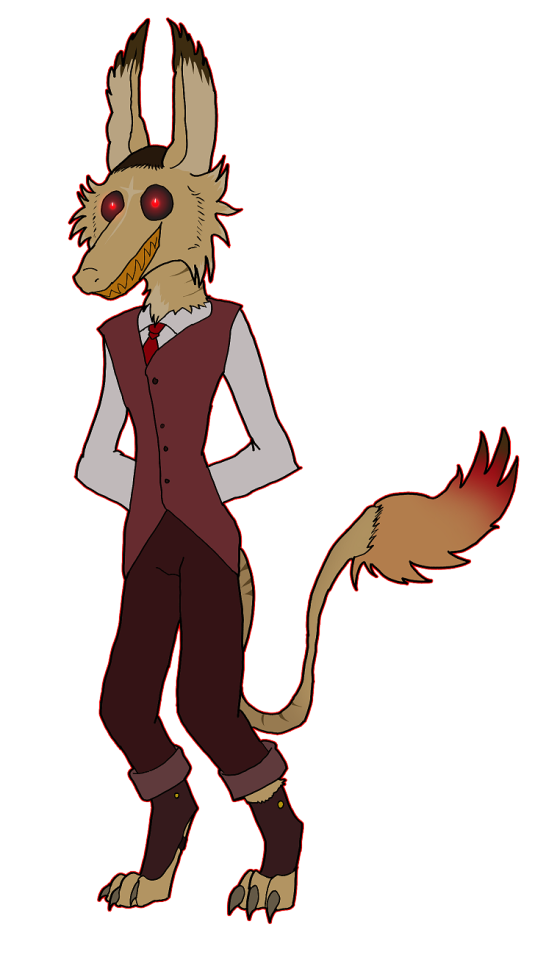
So I decided to join the redesign crowd. With the most redesigned character, of course.
Design notes under the cut.
Alastor's design and character concept both have bothered me for a while.
For one, him being a cannibalistic deer came far too close to a certain cannibal spirit of the north. When Al here is very clearly a SOUTHERN person. Second, his outfit is not 1920s at all. Third, this and all of his other traits are not well-depicted in his design at all.
Here is what I did;
-I replaced the cannibal spirit with a hare and a Beast of Gevaudan inspired rougarou. The Beast of Gevaudan was an orange long tailed creature with stripes, a mystery. Just like Alastor. Hares are often associated with witchcraft and a rougarou is a local monster that fits him as a punishment. As monstrous on the outside as he is inside.
-The outfit is just a 1920s men's outfit.
-Though not visible outside his teeth and eyes, Alastor's body is a construct of brass, wires, electronics and such. His soul is trapped in this construct and it is not known if he actually died or if the deities he once pretended to worship are keeping it in limbo.
-Used to follow voodoo/vodou but his serial killings and general disrespect made his Loa ask Baron Samedi a favour.
24 notes
·
View notes
Text
Gran Bwa. Vodou Spirit Of The Forest.

This lwa of one of my favorite I'm going to speak a little about him.
Gran Bwa is a big part of all forms of voodoo. He is the lwa of the forest, he's a healer who has power of the sacred forest. He is a powerful lwa. He may or may not be of Congolese origin originally, but some believe have originally been a Taino spirit incorporated into the Vodou pantheon.
What Nation Is Gran Bwa From? He is from the Rada Nation, Not Petro like the internet says. He is a patron of initiations. Gran Bwa is considered the Tree of Life that connects the celestial realms with those of the living and the dead. I won't say he is the ruler of the forest but it's protector and you can find him their or at any tree if needed.
Gran Bwa can help you make baths and washes,wanga bottles, packet etc. He is a great healer who can bring luck to you and he would come to your defence. He can break strong black magic and curses and cleanse negativity. He can help you connect to your ancestors and your spiritual home in Vodou.
Gran Bwa is the Shade tree, Giving tree, Medicine tree, and the Hanging tree all at the same time. Tell him what you require and he'll help you.
If you follow the Catholicism path he is synchronize with Saint Sebastian.
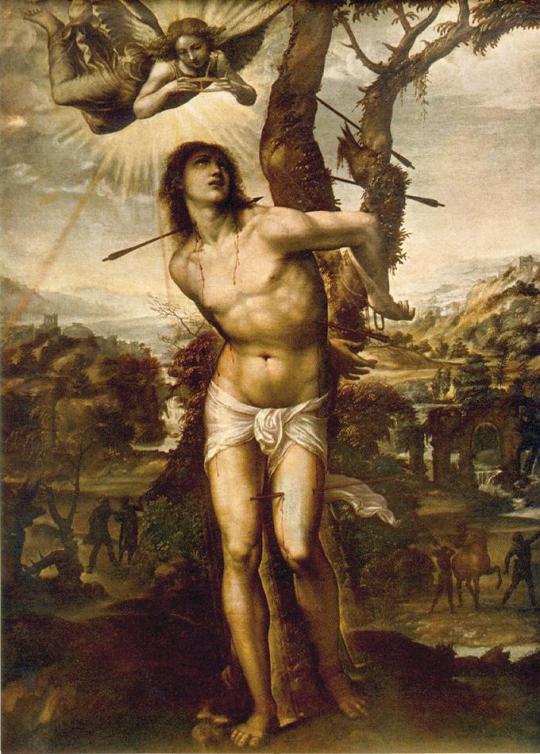
St. Sebastian photo.
In other African religion like Puerto Rican Sanse, he is St. Sebastian or St. Jude.
Even thou voodoo spirit aren't saints he knows who your truly speaking too when you call apon him.
ANIMALS: He protects all forest animals.
COLOURS: Green or Red.
DAY: Saturday.
ALTAR: You can hang offerings from a any tree branch or lay them at the foot of the tree. Your altar is fine also.
Where To Find Him: You can find him in any forest area. Are if you have a place with a large old tree or a sacred tree (Eggun Tree) you'll find him their.
OFFERINGS: He likes green leaves and herbs, even braches if it's picked from a forest. Tobacco, Rum.
#Gran Bwa#vodou lwa#Voodoo lwa#louisiana voodoo#haitian vodou#vodou deities#vodou loa#google search#like and/or reblog!#follow my blog#Healing spirit#african diasporic#african spirituality#Spirit energies#ask me a question#ask me anything#message me
10 notes
·
View notes
Text
Vodou symbolism in Castlevania Nocturne
Vodou developed among Afro-Haitian communities amid the Atlantic slave trade of the 16th to 19th centuries. Its structure arose from the blending of the traditional religions of those enslaved West and Central Africans, among them Yoruba, Fon, and Kongo, who had been brought to the island of Hispaniola. There, it absorbed influences from the culture of the French colonialists who controlled the colony of Saint-Domingue, most notably Roman Catholicism but also Freemasonry. Many Vodouists were involved in the Haitian Revolution of 1791 to 1801 which overthrew the French colonial government, abolished slavery, and transformed Saint-Domingue into the republic of Haiti.
At the heart of Vodou are the symbols known as vèvè. These cosmograms are intricate drawings made with cornmeal, coffee, or flour, and they serve as the visual representation of the spirits and deities (known as lwa, also called loa or loi) honored in Vodou. Each vèvè corresponds to a specific spirit, and invoking them involves drawing the corresponding symbol on the ground. This is often performed by an initiate who has learned the technique and is an essential part of Vodou rituals and ceremonies.
Let's look at some of the symbolism shown in Nocturne.
1. Agwe Arroyo or Agwe Tawoyo/Agwe 'Woyo - "Agwe of the Streams"
Captain of Immamou, the ship that carries the dead to the afterlife. He cries salt-water tears for the departed. He assisted the souls of those that suffered crimes against humanity during the trans-Atlantic slave trade. Agwe is called to calm the waves of the sea or ensure happy sailing, but mainly he is worshipped by those who fish and whose life depends on the life in the waters. People under his protection will never drown and water will never harm them.
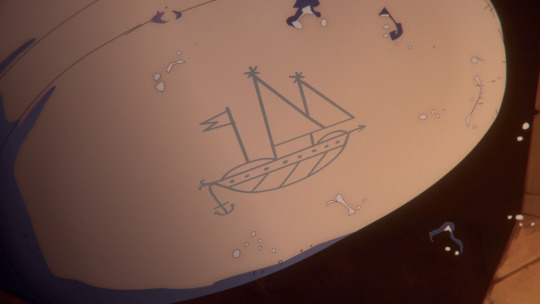

2. Kouzen Zaka, or Azaka
The patron lwa of farmers, but he is also known as a lwa travay, a work lwa. Kouzen Zaka, represented by this vèvè, is the guardian of the fields in Haitian Vodou. The drawing of his symbol showcases elements of agricultural activity, including the earth, machete, sickle, hoe. Zaka is closely tied to work and is revered by farmers and those who rely on agriculture for their livelihood.


3. Erzulie Dantò or Ezilí Dantor
The main lwa of the Petwo lwa family in Haitian Vodou. She is a powerful and protective mother figure, often depicted holding a knife, symbolizes justice and will forcefully fight to protect her children, who are her loyal followers. She is a single mother, a Haitian peasant who is fiercely independent and takes care of her own, a strong protector of women and children.

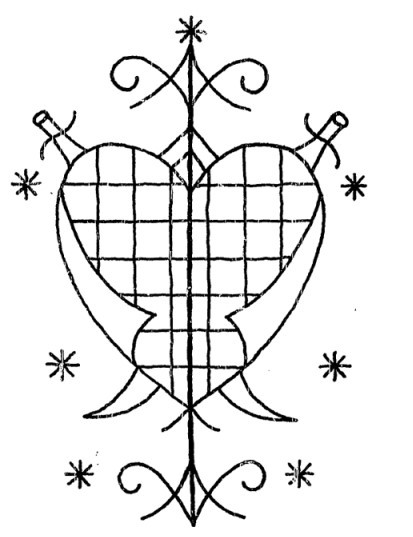
4. Legba: The Guardian of the Gates
Papa Legba, the first spirit to manifest during a Vodou ceremony, holds a special place in the Vodou Pantheon in Haiti. His vèvè symbolizes his role as the barrier between the two worlds, with two perpendicular axes and his cane. Known as a trickster Loa, he usually appears as an old man on a crutch or with a cane, wearing a broad-brimmed straw hat and smoking a pipe, or drinking dark rum. The dog is sacred to him. He carries a sack on a strap across one shoulder from which he dispenses destiny. He is believed to speak all human languages. In Haiti, he is the great elocutioner: Legba facilitates communication, speech, and understanding. During Vodou ceremonies he opens the spiritual gateway that separates the Loas from our physical world.
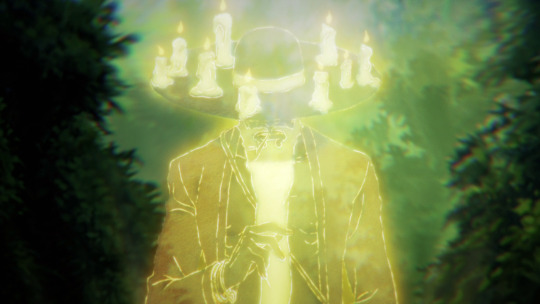
In addition, Papa Legba is the guardian of portals, doors, and crossroads. His role is critical in any Vodou ritual, as he's the one who grants access to the other Loas and allows them to manifest themselves during the ceremony.
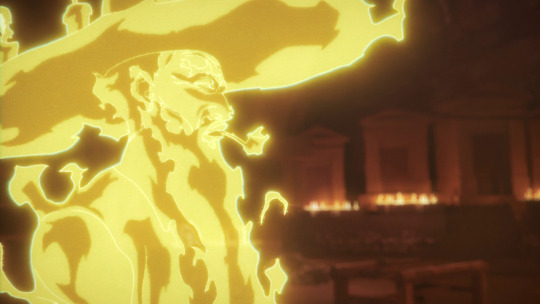
What we hear Annette chant in the series is 'Papa Legba: Ouvè Baryè'a' (Papa Legba: Open the Gate).
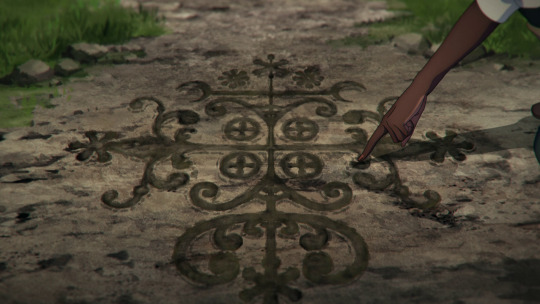
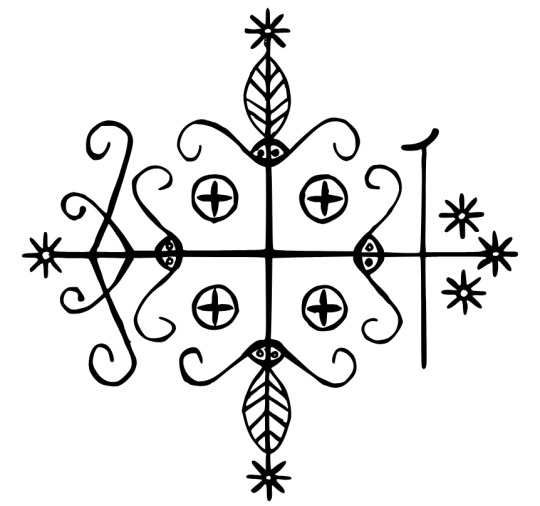
There's a lot more to dive into, but this was a summary.
21 notes
·
View notes
Text
The Great Handfasting Project: Pagan Wedding Planning Books

In February, my partner and I will be celebrating our third anniversary. Like many people who have been dating for a while, we've decided to get married. Because we're both pagan, we've always known that we wanted a pagan wedding. But because neither of us is Wiccan (I'm a Heathen and he's a Roman pagan), we knew that our pagan ceremony probably wasn't going to look like a typical neopagan wedding. And, since we live in an area that doesn't have a lot of pagan resources, we knew we would be planning the ceremony and writing the ritual ourselves.
We are going to be having a true handfasting -- a Celtic-style marriage ritual that includes actually binding the couple's hands together with cord or ribbon. We're both Irish American, and we both incorporate Irish elements into our spiritual practices, even though we both have other stuff going on. We chose Lughnasadh (August 1st) as our wedding date because it's a traditional time for handfastings in Ireland, and we will be incorporating the binding of the hands. However, we're also planning for the ceremony to include lots of Norse and Roman elements. The cool thing about writing your own wedding ritual is you can include whatever religious or cultural elements are meaningful to you. (Provided you're not stealing from closed traditions you aren't a part of.)
Because I feel like struggling to plan a modern pagan wedding ceremony is a pretty common experience, I'm going to be sharing a lot of our research and planning process on this blog so you can learn from our experiences and (I'm sure) our mistakes. I'm calling this "The Great Handfasting Project."
Step one of wedding planning, as with so many things in revivalist spirituality, is research.
(I am aware that Raven Kaldera and Tannin Schwartzstein have a book on handfasting. However, I personally do not feel comfortable reading or reviewing anything with Kaldera's name on it because he has been accused by multiple former followers of some truly horrific abuse and exploitation. Aside from any ideological issues (and I do have several), I don't think someone who openly uses religious rituals to act out rape and torture fantasies is the type of person I want to take wedding planning advice from.)

Modern Handfasting: A Complete Guide to the Magic of Pagan Weddings by Liz Williams
(2021, Llewellyn Publications)
This was the first book I read after my partner and I decided we wanted a handfasting. Overall I felt like it was a great guide to modern handfasting ceremonies, especially the logistical side of planning one. (Can a handfasting be legally binding in my country? How do I handle family members who aren't pagan? What kind of venue should I book for my handfasting? Etc., etc., etc...) At the same time, this book is definitely focused on handfastings and doesn't really talk about other types of pagan wedding ceremonies. The wedding planning advice is still good, but if you're not planning a handfasting for your ceremony, the sample rituals won't be as helpful.
Pros:
Very thorough advice on how to plan a non-traditional wedding. After reading this book, I had a good idea of all the logistical stuff I’d need to do for my own wedding.
Queer and trans inclusive! The author includes extra advice and information specifically for queer couples and couples in which one or more partner(s) is trans.
Polyamory affirming! While this book mainly focuses on ceremonies with two partners, the author does talk a little bit about poly handfastings and about historic precedents for polyamory in paganism.
I liked how the author included mentions of love and marriage deities from other religions, like Hinduism and Vodou, while also talking about the dangers of cultural appropriation and making it clear that readers should seek out a clergy in those religions if they want to form a relationship with those deities.
The book is mostly very well-researched and transparent about sources.
Includes anecdotes from people who have been handfasted and from celebrants who have performed handfastings, including non-pagans.
Includes information on the legal status of pagan marriages in many different countries.
Cons:
While the author frequently mentions other traditions, most of the rituals given in this book are very much Wiccan handfastings. There’s a lot of emphasis on Wiccan ritual elements like calling the quarters and tools like athames and chalices. As someone who is not Wiccan, a lot of this just wasn’t relevant to me.
There’s not much mention of other ritual formats pagan weddings can take — which is fair, since handfasting is in the title, but this book will be less helpful to someone planning a Hellenic or Kemetic wedding, for example.
While the research is mostly pretty good, the author will occasionally come out of left field with something really “out there” and provably false, like saying that Odin’s horse Sleipnir has nine legs. (He has eight.)
The flower, herb, and tree correspondences given in this book mostly feature European species. Less helpful if you’re outside of Europe and want to use native plants in your wedding.
Overall Rating: 4/5
Do I recommend it? Yes
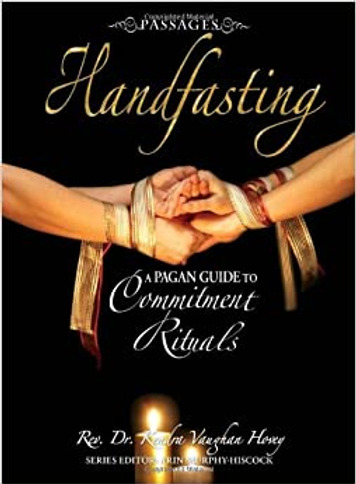
Handfasting: A Pagan Guide to Commitment Rituals by Rev. Dr. Kendra Vaughan Hovey
(2007, Provenance Press; part of the Passages series)
Although the title just says "pagan," it's made explicitly clear in the first few pages that this book is about neopagan handfasting traditions. Except not really -- the author is clearly talking about Wicca exclusively (she talks about the God and Goddess a lot and quotes from the Wiccan Rede), but she keeps insisting that these are things all neopagans believe and do. (They aren't.)
Pros:
There’s some good advice for interfaith couples, like making an effort not to prioritize one religion over the other and talking about how you’d like any kids to be raised before you get there. I especially like that the author talked about the importance of respecting your partner’s beliefs and not pressuring them to participate in your rituals.
I like that the author encourages people to incorporate family traditions, cultural traditions, or even religious traditions from their childhood if they were not raised pagan. There’s a big emphasis on personalizing your ceremony.
I enjoyed the section on themed weddings.
I appreciated that this book had information on choosing an engagement or wedding ring stone based on its magical associations.
Cons:
The author encourages couples to pick the gods they call on in their wedding ceremony based on the outcome they want that god to bring to their union. This is a big no-no because it reduces the gods to just another list of correspondences rather than autonomous beings deserving of respect.
This book contains A LOT of pretty major misinformation, like listing Pachamama as an Aztec deity (she’s worshiped by indigenous peoples in the Andes, which is fully on a different continent than the Aztec empire) and calling the Irish goddess Aine a moon goddess (she’s a solar goddess).
So much cultural appropriation. So. Much.
The author uses a lot of gendered, biological-essentialist language and insists on the importance of invoking one god and one goddess in your handfasting ceremony. There’s also a lot of penis-in-vagina sexual imagery. If you are anything but a cishet person marrying another cishet person, this is going to feel kind of icky.
The author explicitly says that pagans need to be “model citizens” (her words) and have a responsibility to make their religion look good to outsiders. That didn’t sit right with me — I don’t think anyone should live their life based on how other people might perceive them, and I definitely don’t think my wedding needs to be an advertisement for the virtues of paganism.
The author is weirdly, aggressively, anti-divorce? Even in cases of abuse or cheating? This is a direct quote from the book: “If we want our marriage to work out, it can. All we have to do is really want it.” Yikes! This kind of advice coming from a well-known reverend and high priestess is the type of thing that leads people to stay in unhealthy or abusive relationships because they feel guilty for “giving up” on their marriage.
The author is also weirdly fixated on sex and, more specifically, sexual monogamy. Normally this wouldn’t bother me, because I get that most people who want to get married are monogamous. But open marriages do exist, and can be very healthy. Not only does this book ignore that, it gets downright preachy about the importance of sexual exclusivity.
Overall Rating: 1.5/5
Do I recommend it? No. This book is 40% bad advice, 40% misinformation, and 20% information that is delivered better in the Liz Williams book.

Romantic Guide to Handfasting: Rituals, Recipes, and More by Anna Franklin
(2016, Llewellyn Publications)
Again, this book is heavy on the Wiccan influences, but it's not quite as bad as the Kendra Vaughan Hovey book -- at least t his author acknowledges that not all pagans are Wiccans.
Pros:
Gay affirming! There’s even a section specifically about gay deities to invoke in your wedding.
There’s a nice section on the history of handfasting, and on the origins of other traditions that are common in modern pagan weddings, like jumping the broom.
I liked that there was a section on wedding clothing, including tips for choosing what to wear for your ceremony.
The section on magical botanicals included detailed instructions for blending your own incenses and oils, which is helpful for readers who aren’t experienced with making their own blends.
There’s a pretty lengthy section on brewing your own wine, mead, and/or beer for the wedding feast, and it actually inspired me and my partner to do this for our handfasting feast!
I like the chapter on handparting, and I like that it includes a sample handparting ritual.
Cons:
A lot of misinformation in the deities section. For example, I don’t think most Hellenic pagans would consider Aphrodite an “Earth Mother” goddess, and as a Heathen I can definitely say that this author fully made up a new myth about Freyja, then portrayed it as an Old Norse story.
Once again, cultural appropriation rears its ugly head.
Uses the word “transsexual” interchangeably with transgender. This is an outdated term that is considered offensive by some, and by 2016 allies definitely knew not to use it.
The sections on gay weddings are much shorter and less well-researched than the sections for straight weddings. This, combined with the outdated language, makes me wonder if the author originally wasn’t going to include any info for queer couples but was pressured to add it in by her publishers. It feels insincere.
Uses the g-slur to refer to Romani people. And then suggests a [g-slur] theme as a potential wedding theme. In a book written in 2016???
Overall Rating: 2/5
Do I recommend it? No. There's some useful info, but you can definitely find that info in other books that don't contain multiple slurs (!!!) and copious misinformation.
#the great handfasting project#handfasting#wedding#pagan wedding#books#pagan books#liz williams#kendra vaughan hovey#anna franklin#llewellyn publications#inclusive heathenry#irish pagan#irish paganism#irish polytheism#heathen#heathenry#religio romana#roman paganism#roman polytheism#wedding magic#wedding witchery#witchblr#witch#wicca#long post#my writing
121 notes
·
View notes
Text

Rainbow Spirits
Through many cultures the rainbow is something magical and sacred. These are some of the deities and spirits associated with the rainbow
Manzat: Mesopotamian and Elamite Goddess who was the personification of the rainbow
Iris: Greek Goddess who personifies the rainbow, or in other myths, the rainbow is the path she travels as the delivers messages from the Gods to the human realm
Rainbow Serpent: Aboriginal Australian Creator god who also controlled the rain
Hong: Chinese two-headed Dragon who represents the rainbow
Ix Chel: Mesoamerican Goddess of rain, birth, and healing. Chel means rainbow.
Anuenue: Hawaiian messenger Goddess to her brothers, Tane and Kanaloa. She is the Rainbow Maiden.
Oxumare: Yoruba Orisha who is the personification of the rainbow.
Ayida-Weddo: Haitian Vodou Loa who is the personification of the rainbow
Dan: West African Vodun spirit who is represented as a rainbow serpent. Dan is the androgynous son of Mawu, the Divine Creator, and acts as a mediator between the spirits and the living.
Uenuku and Kahukura: Māori atua's and prominent ancestors, both of which are personifications of the rainbow, and usually represent omens.
Cuchavira: Meaning "shining air", she is the personification of the rainbow and protectress of working women and the ill for the Muisca, the indigenous people of the highlands in the Andes.
Amitolane: Rainbow spirit from the mythology of the Zuni, a Native American tribe.
Prende: Albanian Goddess of the dawn, love, beauty, fertility and health. Her belt was said to be the rainbow.
Indra: Hindu God who is the King of the devas and Svarga. He is a God of the sky, lightning, weather, thunder, storm, rain, and war. In Sanskit the rainbow is called the "indradhanus" or the Bow of Indra.
Rama: Hindu hero-king who was the seventh avatar of the God Vishny in the Vaisnava tradition. A Bengali word for rainbow is "rongdhonu", meaning Rama's Bow
Rainbow Prince: French fairytale prince who can only speak when there is a rainbow
Christian God: After the devastating flood that killed all life except for fish and the animals and people on Noah's Ark, God made a promise to never again destroy all life in this way. He gave Earth the rainbow as a symbol of this covenant.
Leprechaun: being from Irish myth that is sometimes classed as one of the Aos Sí. The leprechaun was thought to guard the pot of gold at the end of the rainbow.
Unicorn: A new link between the mythical unicorn and rainbows has been forged, where these have become almost inseparable. It is unsure where this first started. Unicorns symbolize purity, blessing, healing, and freedom.
[Part of a Rainbowmancy series, masterpost here]
#rainbowmancy#rainbow magic#rainbow witch#deity#rainbow#magic#spirits#unicorn magic#witch#witchcraft#witchblr#paganblr#symbolism#mine#personal
11 notes
·
View notes
Text
Rainbows
A common motif in mythologies across the world is to zoomorphize the rainbow as a serpent or dragon. Examples of this include:
The Balaur is said to travel along rainbows, or in Romania the rainbow itself is a two-headed Balaur.
In parts of Ukraine, the Rainbow is called tsmok, a common term for Slavic Dragons. It drinks water from the ground and transports it into the sky, where it becomes rain.
Hong is a Chinese Word for Rainbow, which is depicted as a dragon with a head on either end. This term, as well as the other two words for rainbow: didong and ni, all contain Radical 142, a radical associated in the Chinese language with insects, reptiles, and dragons.
Ayida-Weddo is a snake loa found in Vodou, which is associated with, among other things, Rainbows. This loa is connected to a similar figure found in West African mythology, who holds the world in their coils.
Aboriginal Australian mythology has a wide range of Rainbow Serpent deities and entities.
79 notes
·
View notes